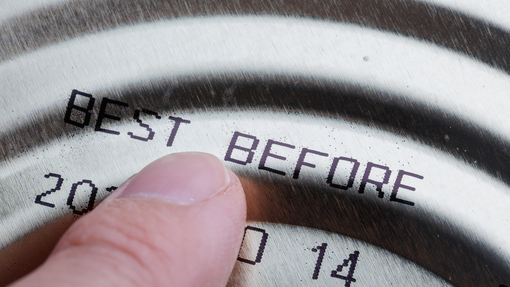
Getting to grips with the switch to ‘Best before’ dates on milk
Some positive food news; you’ll start seeing supermarkets changing to a ‘Best before’ date on dairy foods, including milk, following the lead from pioneers Arla (Cravendale & BOB), Morrisons, M&S, Aldi and Sainsbury’s.
But why? Switching to ‘Best before’ dates is a real bonus for us as it means that we are now reassured that using our judgement on whether milk is still good to use after this date is okay to do, rather than chucking perfectly tasty milk down the sink. Storing milk in the fridge and making sure the fridge is kept at 5°C or below will preserve the freshness for longer.
It’s great for us all as we’ll get more value out of the milk we buy, helping to make our precious money go a bit further, and it’s a simple way to help protect our planet too.
Did you know?
- In UK homes, 70% of food that’s thrown away could have been eaten – a whopping 4.5m tonnes.
- Milk is the third most binned food in UK homes.
In this blog, we aim to demystify this recent change to dates on milk and share how this will benefit you, your pocket and the planet.
Firstly, a bit more about this change on milk
WRAP, our parent organisation, is working with all retailers and manufacturers and encouraging them to review whether a ‘Use by’ date is needed on their milk products and, if it is safe to do so, consider switching to a ‘Best before’ date to extend the time we can use the milk in our homes. ‘Best before’ dates are all about the ‘quality’ of food.
As all milk is processed differently, the decision will be made by manufacturers and retailers after undertaking tests, risk assessments and speaking to the relevant industry competent authority.
‘Food businesses are responsible for determining whether it is appropriate to apply a ‘Use by’ date or a ‘Best before’ date to their products. The Food Standards Agency is clear that businesses must ensure that the right type of date is applied to products to help the general public make informed choices and stay safe.’ Food Standards Agency (FSA)
The manufacturers and retailers that have already made the move to add ‘Best before’ dates on milk are confident that their milk is safe to use a few days after the date, if the milk is stored in the correct place; a fridge set at the right temperature of below 5° C.
Why is this important?
By switching to a ‘Best before’ date on milk, we have the reassurance that using our own judgement about using up our milk is a good thing to do. This change gives us a few more days to use up or freeze unspoilt milk for later… meaning we can save a lot of milk, and some precious money, from going down the sink.
‘We understand that the main aim of the changes in relation to milk has been to reduce the amount thrown away, unnecessarily, every year. The FSA welcomes efforts to reduce food waste and moves by food businesses to challenge established practices where this does not compromise food safety and remains within the law.’ FSA
Milk will go sour, look lumpy and not smell okay before harmful bacteria develops. So, using our judgement means we will stop using our milk at this sour, lumpy and smelly stage and before it’s unsafe to consume.
‘Milk will taste, look and smell bad before it becomes bad for you.’ Emily, FSA on Good Morning Britain (ITV), June 2023
And if you still feel uncomfortable or just not sure about using your own sensory cues to decide, we advise that you stick to the ‘Best before’ date the manufacturer has added on the pack that indicates when the food is at its best.
It’s worth taking a moment to listen to this short conversation between the FSA and the presenters of Good Morning Britain about changes to milk dates.
However – and this is important – the guidance around date labels is that you should not eat or use any food after a ‘Use by’ date has expired. So, if you still see a ‘Use by’ date on some milk then you must follow this guidance and not use the milk past this date. The manufacturers and retailers that have switched to a ‘Best before’ date on milk have completed a rigorous review on safety before making this decision.
Being smarter with our milk
Not everything goes to plan, so if you know you won’t use up all your milk before it goes off then why not pop it in the freezer?
Top tip: Splitting the milk into portions will help you defrost only what you need.
If your milk has a ‘Best before’ date then it’s best to freeze it just before this date for peak freshness and it can also be frozen just after this date, using your judgement on the quality.
For milk with ‘Use by’ dates, you can freeze up to the date on the pack and defrost as you need it. Do not use or freeze your milk after this date.
- Smaller cartons of milk – You can freeze and easily defrost smaller milk cartons – just pop them straight in the freezer . If the milk carton is already open then ensure the lid is tightly closed or consider putting it into another container, adding a label with what it is and the date you put it in the freezer.
- Larger cartons of milk – you can freeze these in their cartons or plastic bottles, however, it’ll defrost quicker if you empty the carton into a couple of smaller containers before you freeze the milk. This means that you can defrost only the amount that you need. As above, pop on a label that says ‘milk’ and the date it went into the freezer.
- Dribs and drabs – you can easily save all your milk by adding the last bits left in a carton into an ice cube tray and freezing. All you need to do is pop one ice cube of milk into your cuppa when required!
- Glass bottles of milk – you cannot freeze milk in glass bottles as the milk will expand when frozen and break the glass. Instead, follow the guidance above for ‘larger cartons of milk’.
Helpful food guides
Check out our food guides to explore how to care for your food at home, including the best places to store your food and use up leftovers.
Further browsing
- How do I make sense of food date labels?
- Cravendale & BOB (Arla) Best before story
- Food Standards Agency: Best before and Use by dates guidance
- Blog - Date labels ditched: what this means for you
Frequently Asked Questions
How can you check the freshness of the food if you can’t open it to smell, taste or look at it?
All dairy products will still have a date on the packaging. It’ll either be a ‘Best before’ date indicating the date of peak freshness or a ‘Use by’ date which lets us know that this food is safe to eat up until this date.
Food with a ‘Best before’ date will generally be edible a few days after this date if it’s been stored correctly in a fridge, at 5°C or below.
Food with a ‘Use by’ date will be safe to use up until this date and, as for ‘Best before’, it must be stored correctly in the fridge set at the right temperature.
Most dairy foods can be frozen. Please read the guidance on the labels and you can find out more in our food guides on our website.
Will supermarkets be changing their processes e.g. stock rotation, or removing the opportunity to buy discounted foods?
In-store processes won’t be changing. They will still be working by the date on the foods and many stores still offer discounted products. The benefit of the ‘Best before’ date on some dairy products is that you’ll now have a few more days to eat it.
If you are unsure if the product will stay fresh long enough for you to eat it then go by the date, as you have done before. ‘Best before’ is about the quality and the date indicates peak freshness. You can eat this food a few days after this date. ‘Use by’ is about the safety of the food and you can eat the food up until this date but not after this date.
You can also freeze most dairy products – details will be on the packaging and in our food guides.
How can people with long COVID tell if milk is still good enough to use? Many people cannot smell or taste the food.
If you are unable to test for freshness yourself then we advise that you stick to the date the manufacturer has added on the pack that indicates when the food is at its best. Dairy products will always have a date on the pack.
Isn’t it illegal to remove the dates on products?
There will always be a date on dairy products as it’s illegal to remove them completely. The recent changes are about ‘Use by’ dates being switched to ‘Best before’ dates where it is safe to do so. Some products are allowed to be sold without dates on them for example, fresh uncut fruit and vegetables.





